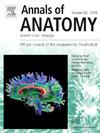人类胎儿的喙臂肌变异。
IF 2
3区 医学
Q2 ANATOMY & MORPHOLOGY
引用次数: 0
摘要
目的:通过对胎儿尸体的研究,证实了胎儿的喙臂肌变异性。进一步分析了成人的胚胎学和系统发育背景以及喙臂肌的变异性。材料:对140例(男34例,女36例)人胎儿上肢进行经典(大体解剖)解剖,10%福尔马林固定。捐赠的胎儿是在自然流产和父母双方知情同意后获得的。解剖在罗兹医科大学解剖与捐赠系进行。解剖后,评估以下特征:1。2.喙臂肌解剖。肌皮神经的起源和走向与喙臂肌有关,3。同时存在的神经和肌肉变异(共变异);喙臂肌头部和神经长度的形态学细节。结果:在140个标本中发现了四种肌肉变异(基于头部数量)。60.7%发现双头肌(典型解剖结构),起源于喙突,肱二头肌短头或喙突。单头肌起源于喙突,占18.6%。三头肌和四头肌分别占10%和10.7%,起源于喙突和肱二头肌短头。在所有病例中,将喙臂肌插入肱骨远端第三段。在有两个或更多头的肌肉的情况下,肌皮神经在浅头和深头之间的路线,而在单个肌肉头的情况下,神经沿着肌肉的内侧路线。发现13例(9.29%)肌皮缺失,其中正中神经支配喙臂肌。结论:与人类成人研究中记录的三种变异相比,根据头的数量鉴定出了四种喙臂肌变异。喙臂肌和肌皮神经解剖(典型和变异)具有重要的临床意义。证据水平:II基础科学研究。本文章由计算机程序翻译,如有差异,请以英文原文为准。
Coracobrachialis muscle variants in human fetuses
Purpose
The current cadaveric study on human fetuses demonstrates the coracobrachialis muscle variability. It further analyzes the embryological and phylogenetic background as well as the coracobrachialis muscle variability in adults.
Materials
Classical (gross anatomy) dissection was performed on 140 (34 male and 36 female) upper limbs of human fetuses, 10 % formalin-fixed. The donated fetuses were obtained after spontaneous abortion and informed consent of both parents. The dissection was performed at the Anatomical Dissection and Donation Department of the Medical University of Lodz. Upon dissection, the following features were assessed: 1. the coracobrachialis muscle’s anatomy, 2. the musculocutaneous nerve origin and course in relation to the coracobrachialis muscle, 3. the coexisting neural and muscular variants (co-variants), and 4. The morphometric details of the coracobrachialis heads and the nerve's length.
Results
Four muscle variants (based on the number of heads) were identified in 140 specimens. A two-headed muscle (typical anatomy) was identified in 60.7 %, with origins from the coracoid process, and the biceps brachii short head or the coracoid process exclusively. A one-headed muscle with origin from the coracoid process was identified in 18.6 %. Three- and four-headed muscles were identified in 10 % and 10.7 %, having origins from the coracoid process, and the biceps brachii short head. In all cases, the coracobrachialis was inserted into the distal humeral third. In cases of a muscle with two or more heads, the musculocutaneous nerve had a course between superficial and deep heads, while in cases of a single muscle head, the nerve followed a medial course to the muscle. Thirteen cases of musculocutaneous absence were identified (9.29 %), in which the median nerve supplied the coracobrachialis.
Conclusion
Four variants of the coracobrachialis muscle were identified according to the number of heads, compared to the three variants recorded in the human adult study. Coracobrachialis muscle and musculocutaneous nerve anatomy (typical and variant) are of clinical importance.
Level of evidence
II Basic Science Research
求助全文
通过发布文献求助,成功后即可免费获取论文全文。
去求助
来源期刊

Annals of Anatomy-Anatomischer Anzeiger
医学-解剖学与形态学
CiteScore
4.40
自引率
22.70%
发文量
137
审稿时长
33 days
期刊介绍:
Annals of Anatomy publish peer reviewed original articles as well as brief review articles. The journal is open to original papers covering a link between anatomy and areas such as
•molecular biology,
•cell biology
•reproductive biology
•immunobiology
•developmental biology, neurobiology
•embryology as well as
•neuroanatomy
•neuroimmunology
•clinical anatomy
•comparative anatomy
•modern imaging techniques
•evolution, and especially also
•aging
 求助内容:
求助内容: 应助结果提醒方式:
应助结果提醒方式:


